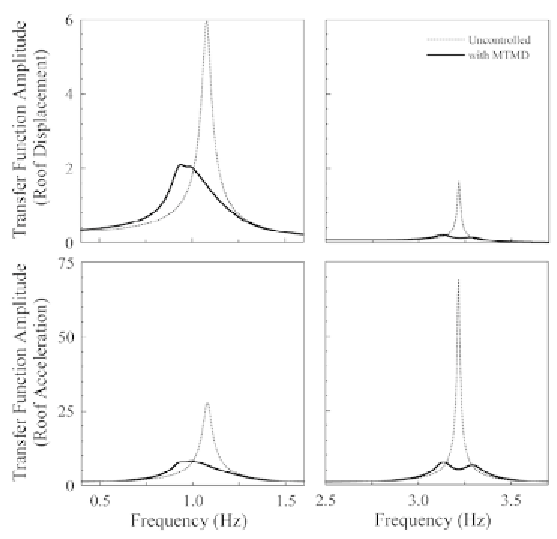Geology Reference
In-Depth Information
Figure 6. Transfer functions of displacement and acceleration at roof of the experimental building near
the first and second modal frequencies (1.08Hz and 3.42Hz) with and without MTMD
tion percentages in root-mean-square (r.m.s.)
response. It is seen that different MTMD control
effectiveness is observed even though all input
excitations have the same PGA. This is because
the frequency content of each input excitation
varies from that of one another, whereas MTMD
is only effective for the structural response of the
frequencies in the MTMD operating range. In the
cases of El Centro earthquake and Chi-Chi earth-
quake, the reductions in peak acceleration were
34.8% and 33.1%, respectively. In contrast, the
MTMD seemed ineffective for the white-noise
case. However, it is seen that the amplification of
acceleration from base (30gal) to roof (38gal,
44.5gal) is small, which means there is no need
to control this white noise induced vibration. These
results showed that the vibration control effective-
ness of MTMD was highly frequency-dependent.
It is always useful once the excitation frequencies
are within its operating range and the structural
response is significant.
ISSUES ON BUILDING MODEL
Since MTMD/TMD is highly frequency-depen-
dent, the accuracy of the building model used for
MTMD/TMD design will be a concern in practical
application. Most of the previous studies regarded
building as a fix-based symmetrical structure. In
real-life situations, a building usually has flexible
foundation and contains some degrees of asym-
metry. Therefore, more or less, the soil-structure
interaction (SSI) effect and torsion-translation
coupling (TC) effect may affect the dynamic pa-
rameters of the building used for MTMD/TMD
design. A building model with TC and SSI effects
suggested by Wu
et al
. (2001) is shown in Figure8.

Search WWH ::

Custom Search